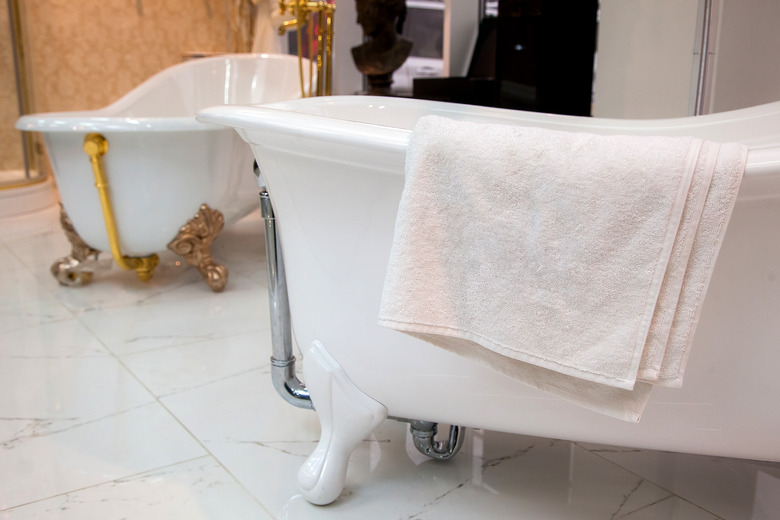Does A Floor Need Extra Support When Installing A Cast Iron Tub?
We may receive a commission on purchases made from links.
Cast iron tubs weigh substantially more than modern fiberglass bathtubs. Regardless of this weight difference though, most standard floors have the strength to support a cast iron tub. If floors do need extra support when installing a cast iron tub, in some instances, such as in older homes, you may choose to reinforce the floor prior to a tub's installation for safety.
Tip
When determining whether your floor needs extra support when installing a cast iron tub, be sure to inspect joists for water damage, but don't forget to inspect damage, knots, or any cuts or notches that may cause loss of strength in the support system for the tub. Make repairs, add blocking or sister joists as needed to shore up the wood prior to installation.
Floor Maximum Load
Floor Maximum Load
With the standard joist size of around 2-by-6 to 2-by-8 inches, and the standard joist spacing of around 16 inches, the standard maximum load of the floor in a room in a house is 40 psf, or pounds per square foot. Regardless of the standard of measure, this maximum load does not actually represent the weight that a floor can support per foot, but the total amount of weight safely supported by the floor.
Standard or Oversized Tub?
Standard or Oversized Tub?
Since a bathtub is a staple item in most homes, the bathroom space is usually built with this in mind. That means that the floor is typically engineered and reinforced to hold even more weight in this room. If you have the original plans for the home, they will come in handy in checking this. In general, unless there is something wrong with the joist spacing or the wood has rotted, the framing in most houses should be able to support a standard size cast iron tub with no problem. A standard size is approximately 32 inches wide by 60 inches long.
If the cast iron tub is an oversized model, or if you aren't sure the framing is up to code, you'll probably want to consult a contractor to see if any support needs to be added to accommodate the tub. Larger cast iron bathtubs may require more joist or subfloor reinforcement for the tub to be safe to use.
Upgrading the Surface
Upgrading the Surface
If you fear that a bathroom floor does not provide enough support for a cast iron tub, or if you just want to be on the safe side, you may choose to upgrade the surface of the floor. The older wood gets, the weaker wood gets, especially in a room where the boards have had constant exposure to moisture. If you see signs of water damage, it's a good idea to swap out the old and add new material. Signs of damage include rotted wood, mold and mildew.
Inspect and replace old wood boards with new wood boards to help provide additional support. You may also choose to switch out old wood floorboards with a flooring material made to bear more weight, such as Oriented Strand Board, or OSB.
Addition of Joists
Addition of Joists
Upgrading the surface of a subfloor is not the only possible solution for reinforcing a floor to support a cast iron tub. A subfloor may also be reinforced from beneath the floorboards. Add extra support to a floor beneath the floorboards by adding additional joists to the floor. Do this by either removing the flooring surface planks all the way across the floor and installing extra joists in the same direction as the original joists or by cutting smaller joists and installing them perpendicular to the original joists in the floor.
